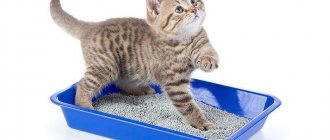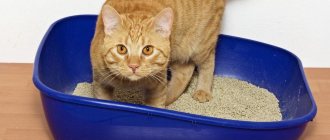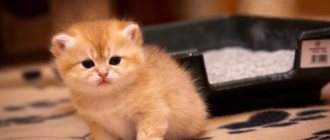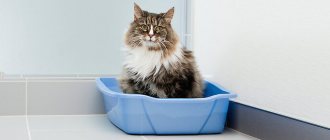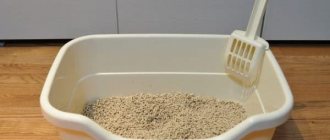The appearance of a kitten in the house is not only a pleasant chore. After all, a new family member needs to be correctly named, housed and toilet trained. It is at this last point that the most problems arise. And it’s not at all about the complex nature of cats.
To teach a kitten to go to the litter box, the owner needs to find out at what age this is done, how to choose a litter and many other subtleties.
At what age does training begin?
The right recommendations will help speed up the long process. Kittens are also children, so there is no certain age for litter box training to be easy and quick. You can force an animal to go potty at 2 months or after 3 months - it depends on its intelligence and learning ability.
If a baby lives with a mother cat, he copies her behavior. The two-month-old kitten is already coping with the task on his own. If the mother is not nearby, the owner can train the cat to use the litter box.
It is not difficult to train a kitten to use the toilet in an apartment, especially when there is a cat nearby, even at 1 month, if the pet is smart. It’s not too late to do this even at 3 months.
How to choose a tray
When purchasing a kitten for your home, regardless of its breed, you will have to buy a litter tray. And the first mistake that new cat owners make is buying a small tray that matches the current size of the pet. Cats grow quickly, and very soon the plastic tray will no longer hold the entire animal. This leads to the fact that the pet sits in a small trough, and its butt hangs over the side. As a result, a puddle forms next to the toilet.
For this reason, when purchasing a tray, you should give preference to large specimens. The assortment of pet stores includes trays with bars, regular trays, and toilet houses. The choice depends on the filler you are going to use. Thus, a perforated tray will be convenient when using industrial bulk fillers. Many owners prefer specimens with bars; the bars help keep the animal’s paws clean.
Choosing a litter box for a kitten
An incorrectly selected tray is one of the first factors that will prevent you from teaching a small kitten to order. Below we consider the types of devices:
- open without mesh;
- open with mesh;
- tray-house;
- self-cleaning.
The correct tray for a cat is wide and with high sides. This is a general requirement for each type.
Open without mesh
A tray without a mesh will not have to be washed every day, and the animal will not injure its paws while trying to dig. But not every type of litter is suitable for it: the cat will carry it around the apartment and scatter it around the tray.
Open with mesh
More complex design. A net is installed on the container where the animal sits. Costs more, but is more hygienic. You can put any filler into the tray; it is inaccessible to the cat.
There are disadvantages:
- The mesh needs to be washed daily.
- The baby will still scratch the surface and may injure his paws.
The main disadvantage of both types of trays is their openness, which makes it more difficult to train a kitten to go to the toilet.
Tray house
An excellent choice for a small living space. It can be placed in the bathroom or hallway. It’s not difficult to make it yourself: the main thing is not to forget about the removable lid to make it convenient to clean. With or without mesh – the owner’s choice.
Important: You can buy an ordinary tray and make a tall, lightweight lid yourself.
Self-cleaning
Premium category trays. Almost no owner intervention is required. Simple models are equipped with a rake for leveling the filler and removing used lumps, a carbon filter to eliminate odors, and a silent motor with which this design operates.
The most expensive models require a constant connection to the network and sewerage.
Sight glitch
It also happens that a kitten goes to the toilet past the tray.
There may be several reasons for this:
- The sides of the container are too high and it is difficult for him to climb over them.
- The pet is still very small and poorly oriented within the boundaries of space.
- He understands that this is a toilet and he needs to go here, but he doesn’t like the filler.
Analyze which of the reasons seems most likely to you. It may be worth changing the container, its contents, or just wait until the baby is a little older and will better understand where the boundaries of his toilet end.
Filler selection
The filler is selected under the tray.
Important: cats do not like scented toilet granules, so using them will not give the desired results.
clumping
Available with or without flavoring. The clumping product is hygienic and easily absorbs moisture and unpleasant odors. The main rule of any litter: the smaller the kitten, the smaller the granules.
Zeolite
Zeolite filler is more expensive than wood filler, but is consumed more economically and absorbs moisture better. It does not stick to the kitten’s paws or fur if a special mat is placed under the tray.
Woody
Cats can taste the litter. The safest option in this case is wood. But without a special rug, the kitten will carry it around the apartment on its paws.
Grain and pulp
Both types are environmentally friendly, relatively inexpensive and made from organic substances. If the kitten accidentally swallows particles of the filler, it’s not scary. Grain and pulp products clump easily.
Silica gel (hazardous to animals if eaten)
One of the most expensive types. This is a substance that is placed in boxes with shoes and bags to absorb moisture and odors. The silica gel filler does not stick to the kitten's fur and paws and does not create a stench, but if there is too much water in the tray, a puddle may form.
It is best to place this litter under the net so that the kitten does not accidentally eat it.
No filler
Need a self-cleaning tray. There is no point in giving up filler in a conventional device. All problems can be solved in other ways:
- spreads on its paws - buy a special mat, then all the granules will remain on it;
- refuses to use - most likely, the kitten does not like litter with a smell or too hard granules;
- better than newspapers - printing houses use toxic ink, the fumes of which are dangerous;
- expensive - the cheapest filler is wood.
What you need to know about trays
Before you train your kittens to a specific place for their needs, you need to purchase a suitable litter box. The design should be comfortable for both the kitten and you. Otherwise, the four-legged one will ignore the place allocated for the toilet and choose its own, suitable for it in all respects.
Almost all trays are made of plastic, but it varies. A chemical smell and a flimsy design that bends under the weight of even a small kitten will be your failure in the training process. Remember that cats have a very sensitive sense of smell and the slightest chemical smell from the litter box will scare them away forever.
Before you train an outdoor kitten or a purebred cat, take a closer look at the animal’s temperament and character
If you have a shy cat or an active kitten who digs into the litter with adoration, pay attention to a closed toilet. Open designs are relevant for owners of several cats
The dimensions of the tray depend on the breed and size of the animal. Of course, a compact “potty” looks neater, but it is hardly suitable for a small breed kitten. But a purebred Maine Coon or an adult British Fold cat is unlikely to appreciate such an infringement of their feline rights. For closed trays, not only the size of the base is important, but also the height. The pet should be able to fully stand on its paws without resting on the “roof”.
Another important parameter is the need to use filler. The design with a grid-limiter is undoubtedly convenient, but not all adult cats will agree to such a tray. It is necessary to teach it from a very young age.
Note! On websites you can often find private advertisements for the sale of used trays; often they are even offered to be given as free gifts. Your cat won’t appreciate such savings; the whole point is that the smell of someone else’s pet will forever remain on the plastic tray, even if you don’t feel it
7 rules of the cat litter box:
Each cat in the house should have its own personal litter box. Yes, one tray for everyone is convenient, but not comfortable for pets. Each time they will try to re-mark a strategic territorial resource in the house
This way you will get endless gang wars between the tailed ones. The location of the toilet should be convenient for the cat, not you, and there will be no compromises on this issue. If you purchased a litter tray, pay attention to how the cat treats it. Sometimes changing the filler to a perfumed one with fragrances can permanently discourage you from using the toilet
It may seem to you that the aroma is pleasant and you are doing everything for the benefit of your pet, but the cat will not think so. After all, he has 200 million receptors, and we have only 5 million. In a filler, not only the aroma or lack thereof is important, but also the consistency. Cats with declaws removed will not be comfortable on litter with sharp-angled particles. Pay attention to your pet's health. The older the cat, the easier and easier it should be to climb into the tray; no high sides, additional doors or intricate details. Often human behavior is projected onto the animal. We are accustomed to the fact that the toilet should be a secluded place, hidden from prying eyes. But cats don’t need this, so not all pets like closed toilets. In addition, the lid on top blocks the view and the cat is not comfortable, because he does not see the likely impending threat. A closed tray with a transparent roof would be a good alternative. The contents of the tray should be removed systematically and, if possible, immediately. Believe me, your pet does not experience any pleasure from moving through a “mined field.”
The process of training a kitten to the tray
Be patient to finish what you start.
Important: Light massage stimulates digestion and the bowel movement reflex; When you sit the kitten on the potty, you can stroke its tummy.
Stage one - getting to know each other
For the first time, they put the kitten in the tray several times, take his paw and help him “dig.” Let the baby not be afraid to sniff the pot and the filler: this way he will get used to the place.
Stage two – observation and assistance
It is possible that you will have to run after the kitten throughout the apartment and watch when it starts meowing loudly, squatting, spinning in one place and scratching its paw on the floor.
Then you need to immediately carry him to the tray and not let him go until he goes to the toilet.
It will not be possible to correct the situation in 1 day, but if everything is done correctly, the cat will definitely get used to it.
Stage three - strengthening the reflex
Now the kitten can be scolded for ignoring the toilet. But not too much. When cleaning up after your baby, you just need to throw everything in the litter tray and take the kitten there when he starts looking for a place to go to the toilet. This must be done without shouting.
Additional tips and tricks
- You cannot hit a kitten or poke its face into the dirt;
- the optimal layer of filler in the tray is 5 cm;
- if the breeder’s baby was constantly lying on moisture-absorbing diapers, you will have to be patient;
- The kitten should also be praised for small progress.
Common Mistakes
- Wrong size of granules: the smaller the kitten, the smaller they should be;
- too early or late litter box training;
- If the baby relieves himself on soft surfaces, you need to put a piece of cloth in the filler.
Where to put the tray
Kittens need privacy for their litter box. This is his personal space. The baby will get used to the tray faster if you place it in a secluded corner where you can easily access it. Living rooms, kitchen, corridor, hall are completely unsuitable places for a cat's litter box; you will have to choose between the bathroom, toilet and balcony.
Usually the cats themselves prefer the toilet, as they understand perfectly well what it is intended for. For owners, this choice of animal is complicated by the fact that the doors there will have to be kept ajar: the kitten may not wait until you figure out why it meows demandingly, and will choose another available place. From this point of view, the bathroom is a more suitable option for the location of the tray.
If you decide to place the tray on a balcony or loggia, keep in mind that there should be no boxes or pots with soil there: the kitten will undoubtedly prefer them to a plastic box. A toilet on the balcony is an ideal option if it is glazed and connected to the room not only by a door, but also by a window with a window, which can always be kept open even in winter. The path to the tray through the window, of course, is a plan for the future. While your pet is very small, you will have to make sure that he always has access to the balcony through the door. If the balcony is not glazed, leaving a kitten alone there is dangerous.
Possible difficulties
If all the recommendations are followed, and the kitten does not go to the litter box, do not despair.
Pet doesn't go into litter box
You need to buy a device that is larger, wider, with higher sides, and it will become easier to teach your cat to go to the litter box.
Pet ignores litter box
If the baby goes to the toilet everywhere, check that the rules for choosing the device, filler and place for the tray are followed. If an already accustomed kitten is mischievous, the advice is the same:
- the tray should be without traumatic elements, preferably without a mesh;
- filler – odorless;
- put it in a dark, secluded place so that the animal is not afraid of anyone.
If the recommendations are taken into account, the pet will be able to go to the toilet where it needs to be. The exception would be a kitten that is too small. A one-month-old baby will not understand what they want from him.
Timely training
It is advisable to accustom a kitten to the tray from an early age. From which one?
As soon as possible, ideally when he reaches four weeks.
Teaching a one-month-old kitten to order will be quite quick and easy.
According to the advice of veterinarians, this particular age limit is optimal for animals to learn new information and skills.
But this requires persistence on the part of the owner.
If the owner does not pay attention to the “dirty things” left in the corners of the apartment and silently removes them, then the pet will decide that this is in the order of things
If you took the baby from a nursery, where until now his mother was looking after him, then you should not flatter yourself with the hope that she instilled good behavior in him.
Best articles: Evolution and development of viruses
As a rule, cats do not train their kittens to use the litter box. Kids can simply copy her actions.
And even if small pets managed to adopt some good habits during the time spent next to her, there is a high probability that the skills will be lost when the situation changes.
Even if the cat mother set an exceptionally good example for the baby, separation from her can lead to a complete loss of this experience.
When a kitten turns one month old and is immediately separated from its mother, it experiences stress, no matter how friendly its new owners are to it.
The baby is lost and often does not control his natural urges.
Here, new owners should show restraint and teach the kitten to go to the litter box on their own.
How long will it take? It all depends on your persistence and the character of the baby.
Is it possible to train a baby to use the toilet of another cat?
Smell is the main safety criterion for cats. The kitten will not use someone else's potty. In this case, even neutral flavors will not help accustom the cat to the litter box.
In order for the baby to learn to use a device that has already been used, the tray must be disinfected and make sure that foreign odors have disappeared.
Toilet training
If home conditions do not allow for space for a litter box, you can train your cat to use the toilet in a different way. The process will take a long time: it will take 1-2 months. To accustom a kitten to the toilet, the tray is carried to it and raised little by little.
When the devices are at the same level, do this:
- the tray is placed on the lowered lid of the plumbing for 5-6 days;
- pour a little litter into the toilet and place the kitten on it;
- To prevent the animal from being scared, you can buy a special attachment.
Litter training a kitten is an important element of upbringing. You can’t do without this skill in an apartment. The owner will need to show will and perseverance. A Persian, a handsome British cat or a cat without a pedigree will learn everything if you don’t hit the baby or yell at him.
How to teach a cat to go to the toilet
It is better to train an older animal to use the toilet. First of all, this is due to its size; a small kitten can simply fall inside.
First of all, the tray is transferred to the toilet. Then they gradually begin to raise the tray above the floor, placing newspapers or cardboard under it until it is equal in height to the toilet. The cat gradually gets used to the position of her litter box.
The next step is to transfer the tray to the toilet lid. After the animal gets used to it, a children's seat is placed on the toilet. Place dishes with filler under the hole. Having seen the filler, the cat will understand what is required of it. After some time, the devices are removed, and the cat has to defecate while sitting on the toilet.
